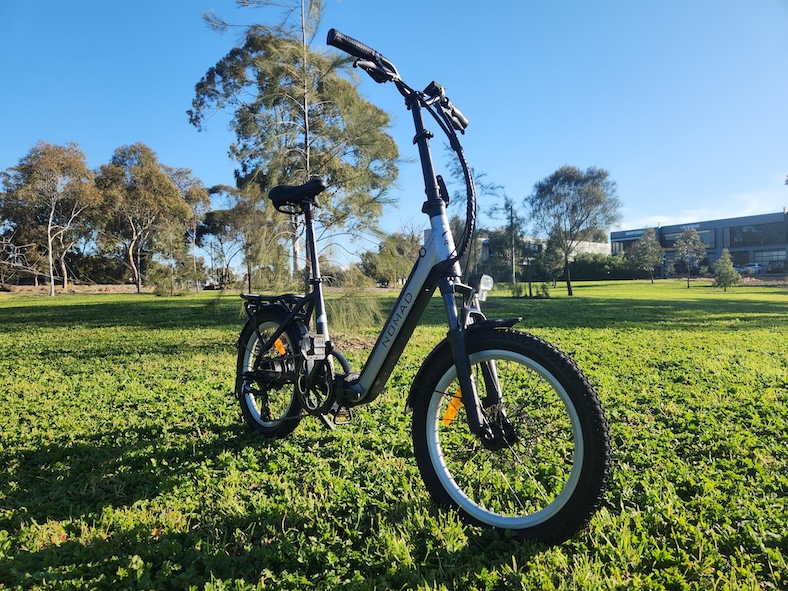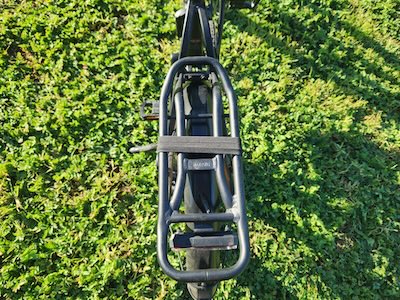Table of Contents
The good stuff
- Adjustability on the go
- Fully equipped with all accessories
- Several speed levels for rider's convinience
Some potential improvements
- Stem markings could help the rider re-adjust it to the rider's prefered lenght
-
Motor assistance & PAS
-
Battery range
-
Weight
-
Responsiveness & Comfort
-
Accessories
-
Technology combo
-
Warranty
The Rilu Nomad is a step-thru folding electric bike, built and designed in Australia for city adventures, including riding on gravel and low-level bumpy terrains.
Rilu E-Bikes loaned this electric bike for testing purposes, and the words are my own. I’m not being compensated to create this review
Nomad Specs Summary (basic)
| E-BIKE MODEL: 2023
PURPOSE: City and Low-Level Gravel Rides MOTOR & TOP SPEED
|
BATTERY
|
RANGE (based on brand information)
|
CONTROLLER, RIDING MODES, & DISPLAY
|
FRAME
|
GEAR SYSTEM
|
BRAKING SYSTEM
|
Rilu Nomad WEIGHT
|
| TYRES & SUSPENSION Tyres:
Suspension:
|
SENSORS
|
FEATURES
|
PRICE & WARRANTY
|
Rilu Nomad Review: My Findings
Terrains tested
My tests were carried out on different terrains, including:
- A gentle gravel path (manufacturer’s intended use) to test maneuverability, tyre grip, and control on loose ground.
- Hard ground with both uphill (about a 20% incline) and downhill sections to test the motor, brakes, and balance (especially on descents).
- Grass and bumpy terrain to test comfort, suspension response, and frame sturdiness.
First impressions
- At first glance, I wasn’t overly attracted to it. The design didn’t immediately appeal to me. But on second thought, it really depends on the angle and lighting.
- Upon closer inspection, I noticed that the frame finish was actually clean and well done. The latches securing the foldable parts appeared strong and of good quality.
For context, I have tested other folding e-bikes before, and the Nomad immediately felt sturdier than most of them.
Test Ride: Speed Levels (SL)
Unlike most brands that use pedal-assist levels (PAS), Rilu opted for speed levels.
Each level was configured to provide a capped speed. During my test, I noticed that the motor cut assistance fairly accurately once the speed limit was reached. However, I also observed that it provided a slight extra push for about a second after I stopped pedalling (worth noting).
No motor assistance
- The Rilu Nomad weight is 24.5 kg, which isn’t light. However, I found the 7-speed Shimano gear system to be smooth and well-tuned, which made riding without assistance surprisingly easy.
- I tested it on flat ground and some mild hills, and for a medium-to-heavy e-bike, I found it effortless enough to ride without power.
This was important to me because some heavier folding e-bikes I’ve tried felt hard to ride without motor support.
SL1 (lowest speed)
- The SL1 was configured to provide assistance of up to 7 km/h. After reaching this speed, the motor would cut off.
- On flat terrain, the SL1 gave me a gentle cruising riding experience.
- When going uphill, it struggled. I had to pedal hard to get to the top of the hill.
That said, the cutoff at 7 km/h confirms that this level is more suitable for cruising.
Note: I should mention that the brand objective with this SL was to help riders get back to riding after a prolonged period of inactivity.
SL5 (middle speed)
- The SL5 assisted up to 19 km/h. Similar to SL1, gear 4 was selected.
- Clearly, on flat terrain, the Nomad provided me with quite good assistance, reaching its top speed in less than 4 seconds.
- On the incline, my ride felt effortless, pedalling very gently with minimal cadence increase.
Overall, the power provided on both terrains was similar, and I didn’t notice any signs of struggle climbing the hill.
SL9 (highest speed)
- The final motor test was conducted with SL9, achieving a maximum speed of 25 km/h (the maximum allowed under Australian e-bike regulations when pedalling).
- On this occasion, my test targeted the challenging incline only. As expected, the Nomad performed well.
Overall, I noticed no real difference between SL5 and SL9 in terms of power; however, I think it’s perfect for maintaining a steady 25 km/h speed uphill with ease.
Test Ride: Comfort and Ride Feel
- It is uncommon to see a folding e-bike with front suspension and a seatpost that offers slight shock absorption capabilities. For me, this was a good addition.
- One of the most noticeable aspects was how balanced the bike felt when turning at higher speeds, particularly in terms of control and maneuverability.
- I was surprised that it didn’t have the usual “wobbly” take-off effect that folding bikes often do.
After a 30-minute continuous ride on mixed terrain, I still felt comfortable, with no back strain or wrist fatigue.
Tip: Adjusting the handlebar slightly forward shifts your centre of gravity, improving control when taking off.
The Rilu Nomad Controller & Display Features
The controller seemed basic compared with other big brands, such as the Bosch Kiosk smart system models. Nevertheless, I liked that:
- Everything was housed in a single unit,
- All the basic information was accessible,
- Its operation was straightforward.
Controller error messages
One standout feature I appreciated was the ability to display real-time error codes in the event of a failure with the motor, battery, or controller. Many big-name systems require a smartphone app to find the errors.
Tip: to find out what the error message means, I suggest reading the brand’s provided manual; it is handy.
Rilu Nomad walk-assist mode test
This mode came in very handy when I had to walk the bike and cross some obstacles on the gravel road.
- My first test involved using the throttle feature (discussed in more detail in the next section). Using the throttle at 6 km/h felt too fast for safe walking.
- My second test was with the actual walk-assist feature, which was very simple to activate (pressing and holding the “M” and “-” controller buttons simultaneously for 3 seconds). I was able to gently take off, with a maximum walk-assist mode of 4 km/h.
Overall, from a safety perspective, it is better to use the dedicated mode rather than the throttle feature.
The Throttle Feature
A hot topic in Australia, since e-bike laws are strict.
Read my article if you want to find out more about e-bike laws.
- It was equipped with a throttle device that allowed me to reach either 6 km/h or 20 km/h maximum speed options. I felt the motor provided the same amount of power for both options.
- I liked that it is a thumb-triggered version rather than a twist-and-go, which could be bad for the wrist over time. My initial experience was good as it was big enough to control with my thumb, and its operation was simple.
- Curious if the Nomad complies with the e-bike regulations in Victoria? The short answer is yes, as the motor is rated at 200W, and cutting at 20 km/h (throttle).
Overall, I think this feature was a great inclusion, as it provided gentle support when taking off and maintained a smooth momentum along the trail.
Nomad Folding & Unfolding Experience
- As I mentioned in my real-time review, it took me some time to understand how to fold it, even after seeing it happen. However, with a bit of patience, it made sense.
- The unfolding process was simpler as it was just reversing the process. The tricky part was at the end, when keeping the frame together until the primary latch was locked.
Tip: I realised that pressing and holding the rear brake would keep the bike stationary, making the folding/unfolding process much easier.
I liked that the folding process was not overthought. Comparing it with other folding e-bikes, I think it wasn’t as complex as I initially thought it would be.
Things I Loved About the Nomad
1. Adjustability on the go: quick-release latches make handlebar and seatpost adjustments tool-free.
2. Fully assembled: as a commuter e-bike, it was equipped with everything I would need.
3. Several speed options: I loved the different speed levels, letting the rider select the best alternative for their riding style and needs. Also, thinking about battery performance.
The Potential Deal-Breaker?
So far, the Nomad lands more on the “wow” side than the “nah” side. After my tests, these are things I noted that could be improved:
- Stem markings would be a good addition, as they would help with re-adjustment to the preferred stem length after unfolding.
- Throttle defaults to 20 km/h at startup; 6 km/h would be safer in case of accidental activation.
Overall, I believe these are minor adjustments.
Is the Rilu Nomad Worth It? Verdict
Not many folding e-bikes have impressed me, but the Nomad did. It felt solid, reliable, and versatile—great for cruising, commuting, and light off-road adventures.
The most significant positive conclusion for me was how natural and comfortable it felt to ride over longer distances. Many folding bikes are suitable for short trips, but this one stood out.
I believe the Rilu Nomad step-thru folding e-bike could be ideal for riders seeking a relaxed, long-distance riding experience, with the added benefit of soft off-road fun.
What do you think? Have you tried it? Please share your thoughts in the comments below.






